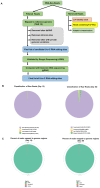Genome-Wide Identification of U-To-C RNA Editing Events for Nuclear Genes in Arabidopsis thaliana
- PMID: 33809209
- PMCID: PMC8001311
- DOI: 10.3390/cells10030635
Genome-Wide Identification of U-To-C RNA Editing Events for Nuclear Genes in Arabidopsis thaliana
Abstract
Cytosine-to-Uridine (C-to-U) RNA editing involves the deamination phenomenon, which is observed in animal nucleus and plant organelles; however, it has been considered the U-to-C is confined to the organelles of limited non-angiosperm plant species. Although previous RNA-seq-based analysis implied U-to-C RNA editing events in plant nuclear genes, it has not been broadly accepted due to inadequate confirmatory analyses. Here we examined the U-to-C RNA editing in Arabidopsis tissues at different developmental stages of growth. In this study, the high-throughput RNA sequencing (RNA-seq) of 12-day-old and 20-day-old Arabidopsis seedlings was performed, which enabled transcriptome-wide identification of RNA editing sites to analyze differentially expressed genes (DEGs) and nucleotide base conversions. The results showed that DEGs were expressed to higher levels in 12-day-old seedlings than in 20-day-old seedlings. Additionally, pentatricopeptide repeat (PPR) genes were also expressed at higher levels, as indicated by the log2FC values. RNA-seq analysis of 12-day- and 20-day-old Arabidopsis seedlings revealed candidates of U-to-C RNA editing events. Sanger sequencing of both DNA and cDNA for all candidate nucleotide conversions confirmed the seven U-to-C RNA editing sites. This work clearly demonstrated presence of U-to-C RNA editing for nuclear genes in Arabidopsis, which provides the basis to study the mechanism as well as the functions of the unique post-transcriptional modification.
Keywords: Arabidopsis thaliana; RNA-seq; differentially expressed genes (DEGs); uridine-to-cytidine RNA editing.
Conflict of interest statement
Authors declare no conflict of interests.
Figures





Similar articles
-
The U-to-C RNA editing affects the mRNA stability of nuclear genes in Arabidopsis thaliana.Biochem Biophys Res Commun. 2021 Sep 24;571:110-117. doi: 10.1016/j.bbrc.2021.06.098. Epub 2021 Jul 26. Biochem Biophys Res Commun. 2021. PMID: 34325125
-
Systematic analysis reveals cis and trans determinants affecting C-to-U RNA editing in Arabidopsis thaliana.BMC Genet. 2020 Sep 3;21(1):98. doi: 10.1186/s12863-020-00907-6. BMC Genet. 2020. PMID: 32883207 Free PMC article.
-
Distinct role of Arabidopsis mitochondrial P-type pentatricopeptide repeat protein-modulating editing protein, PPME, in nad1 RNA editing.RNA Biol. 2016 Jun 2;13(6):593-604. doi: 10.1080/15476286.2016.1184384. Epub 2016 May 5. RNA Biol. 2016. PMID: 27149614 Free PMC article.
-
Plant organellar RNA editing: what 30 years of research has revealed.Plant J. 2020 Mar;101(5):1040-1056. doi: 10.1111/tpj.14578. Epub 2019 Dec 12. Plant J. 2020. PMID: 31630458 Review.
-
RNA editing in plant organelles. Why make it easy?Biochemistry (Mosc). 2011 Aug;76(8):924-31. doi: 10.1134/S0006297911080086. Biochemistry (Mosc). 2011. PMID: 22022966 Review.
Cited by
-
The Genome-Wide Characterization of Alternative Splicing and RNA Editing in the Development of Coprinopsis cinerea.J Fungi (Basel). 2023 Sep 9;9(9):915. doi: 10.3390/jof9090915. J Fungi (Basel). 2023. PMID: 37755023 Free PMC article.
-
Complete chloroplast genomes of Cerastium alpinum, C. arcticum and C. nigrescens: genome structures, comparative and phylogenetic analysis.Sci Rep. 2023 Oct 31;13(1):18774. doi: 10.1038/s41598-023-46017-y. Sci Rep. 2023. PMID: 37907682 Free PMC article.
-
Genome-wide identification and expression analysis of peach multiple organellar RNA editing factors reveals the roles of RNA editing in plant immunity.BMC Plant Biol. 2022 Dec 13;22(1):583. doi: 10.1186/s12870-022-03982-2. BMC Plant Biol. 2022. PMID: 36513981 Free PMC article.
-
Genome-Wide Analysis of Multiple Organellar RNA Editing Factor (MORF) Family in Kiwifruit (Actinidia chinensis) Reveals Its Roles in Chloroplast RNA Editing and Pathogens Stress.Plants (Basel). 2022 Jan 6;11(2):146. doi: 10.3390/plants11020146. Plants (Basel). 2022. PMID: 35050036 Free PMC article.
-
ADAR RNA editing on antisense RNAs results in apparent U-to-C base changes on overlapping sense transcripts.Front Cell Dev Biol. 2023 Jan 6;10:1080626. doi: 10.3389/fcell.2022.1080626. eCollection 2022. Front Cell Dev Biol. 2023. PMID: 36684421 Free PMC article.
References
Publication types
MeSH terms
Substances
Grants and funding
LinkOut - more resources
Full Text Sources
Other Literature Sources

